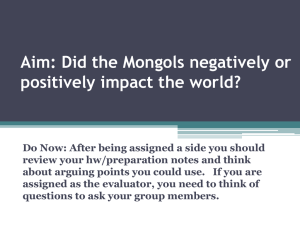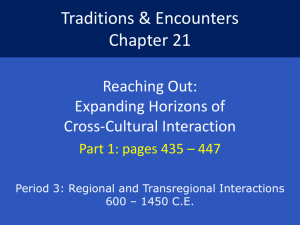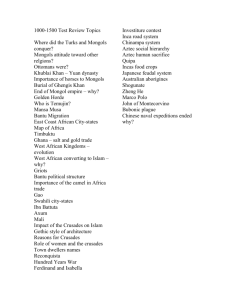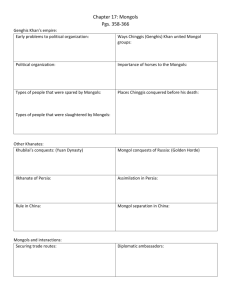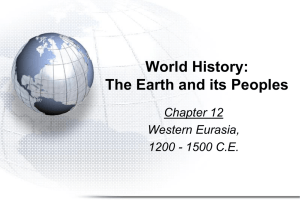DBQ Mongol TerrorMongol Peace
advertisement
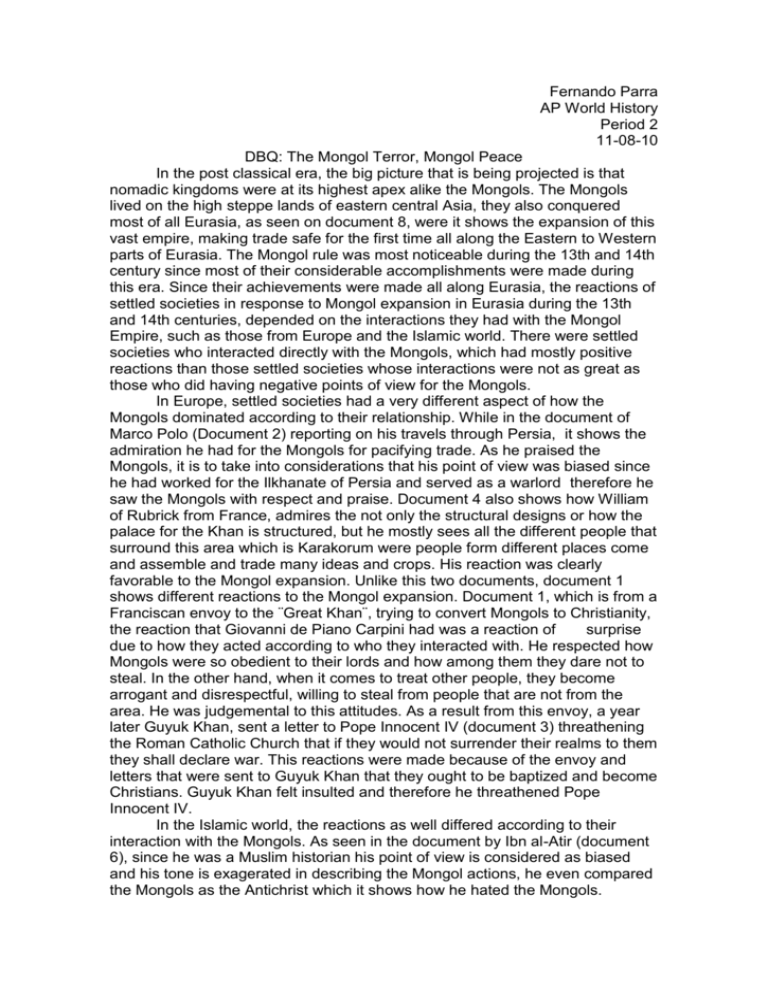
Fernando Parra AP World History Period 2 11-08-10 DBQ: The Mongol Terror, Mongol Peace In the post classical era, the big picture that is being projected is that nomadic kingdoms were at its highest apex alike the Mongols. The Mongols lived on the high steppe lands of eastern central Asia, they also conquered most of all Eurasia, as seen on document 8, were it shows the expansion of this vast empire, making trade safe for the first time all along the Eastern to Western parts of Eurasia. The Mongol rule was most noticeable during the 13th and 14th century since most of their considerable accomplishments were made during this era. Since their achievements were made all along Eurasia, the reactions of settled societies in response to Mongol expansion in Eurasia during the 13th and 14th centuries, depended on the interactions they had with the Mongol Empire, such as those from Europe and the Islamic world. There were settled societies who interacted directly with the Mongols, which had mostly positive reactions than those settled societies whose interactions were not as great as those who did having negative points of view for the Mongols. In Europe, settled societies had a very different aspect of how the Mongols dominated according to their relationship. While in the document of Marco Polo (Document 2) reporting on his travels through Persia, it shows the admiration he had for the Mongols for pacifying trade. As he praised the Mongols, it is to take into considerations that his point of view was biased since he had worked for the Ilkhanate of Persia and served as a warlord therefore he saw the Mongols with respect and praise. Document 4 also shows how William of Rubrick from France, admires the not only the structural designs or how the palace for the Khan is structured, but he mostly sees all the different people that surround this area which is Karakorum were people form different places come and assemble and trade many ideas and crops. His reaction was clearly favorable to the Mongol expansion. Unlike this two documents, document 1 shows different reactions to the Mongol expansion. Document 1, which is from a Franciscan envoy to the ¨Great Khan¨, trying to convert Mongols to Christianity, the reaction that Giovanni de Piano Carpini had was a reaction of surprise due to how they acted according to who they interacted with. He respected how Mongols were so obedient to their lords and how among them they dare not to steal. In the other hand, when it comes to treat other people, they become arrogant and disrespectful, willing to steal from people that are not from the area. He was judgemental to this attitudes. As a result from this envoy, a year later Guyuk Khan, sent a letter to Pope Innocent IV (document 3) threathening the Roman Catholic Church that if they would not surrender their realms to them they shall declare war. This reactions were made because of the envoy and letters that were sent to Guyuk Khan that they ought to be baptized and become Christians. Guyuk Khan felt insulted and therefore he threathened Pope Innocent IV. In the Islamic world, the reactions as well differed according to their interaction with the Mongols. As seen in the document by Ibn al-Atir (document 6), since he was a Muslim historian his point of view is considered as biased and his tone is exagerated in describing the Mongol actions, he even compared the Mongols as the Antichrist which it shows how he hated the Mongols. Contradictory to this document, document 5 is from a merchant´s point of view, Ibn Battuta, who is really affected positively since the Mongols protected trade and merchants. Therefore, Battuta respects and value the Mongols. Although this documents refer to the Mongols one as evil and the other one as admirable, the letter sent to Hulagu Khan by three Shi´te dignitaries of Baghdad, (document 7) they respect and surrend to the Mongols since they noticed by now that it was not worthy fighting them since most likely they would end up getting slaughtered. This fact can be supported by document 9 where Genghis Khan describes all the horrible things he would do by defeating his enemies. While these documents seem to focus on Europe, Islamic world and mostly the high classes, it would be helpful to have documents from China and the lower classes such as the peasants. Since these documents are focused on Europe and the Islamic world we cannot conclude on how the lower classes reacted such as the peasants in the Byzantine Empire where they saw Mongols as liberators but their reactions cannot be determined without a primary source document. In China the reactions might have been different to those reactions in Europe and the Islamic world, due to the fact that the conquered people in China saw the Mongols differently to all those in to the East of China. The reactions of settled societies to the Mongol expansion, differed significantly by how they interacted with the Mongols. The Mongols empire went from East to West and South to North but the way they treated those who interacted with them is remarkable different to those who did not interacted with them directly. The Mongols for some was seen as a demolishing force that destroyed all living thing that surrounded them as they went by and for others, who did interact directly, their praise was not enough to say how much they appreciated the Mongols.
